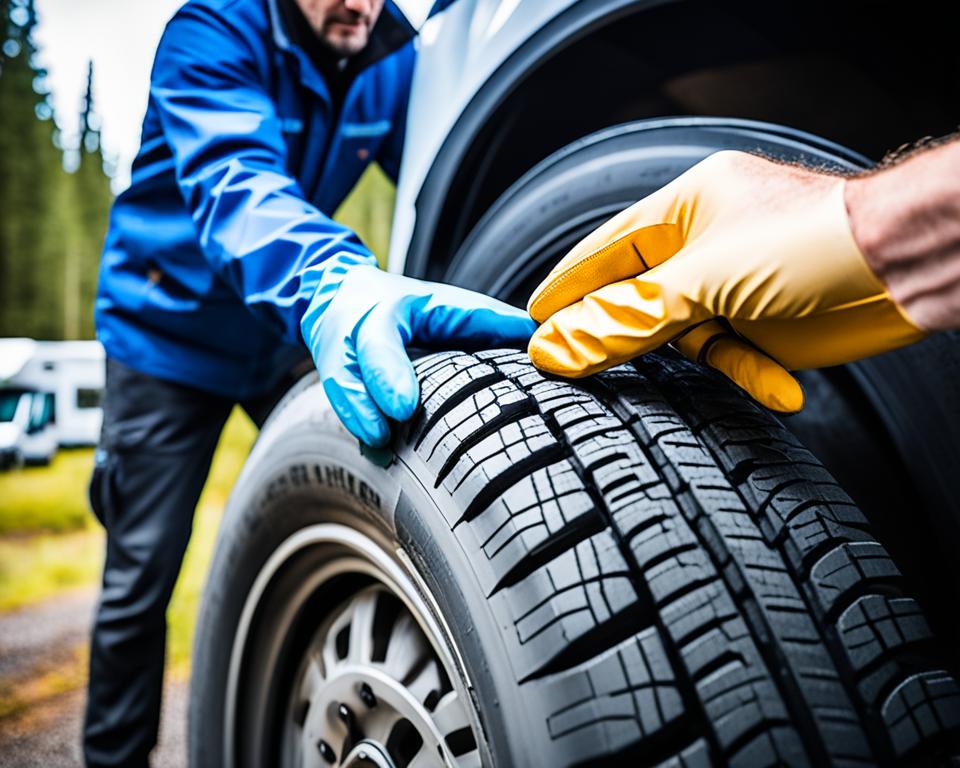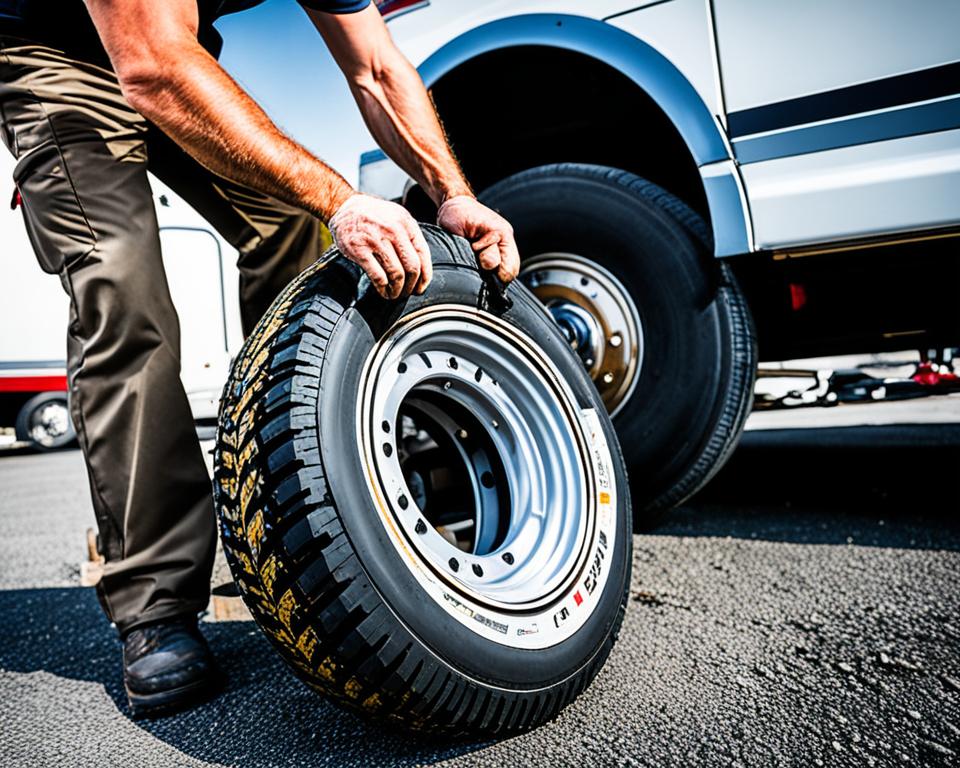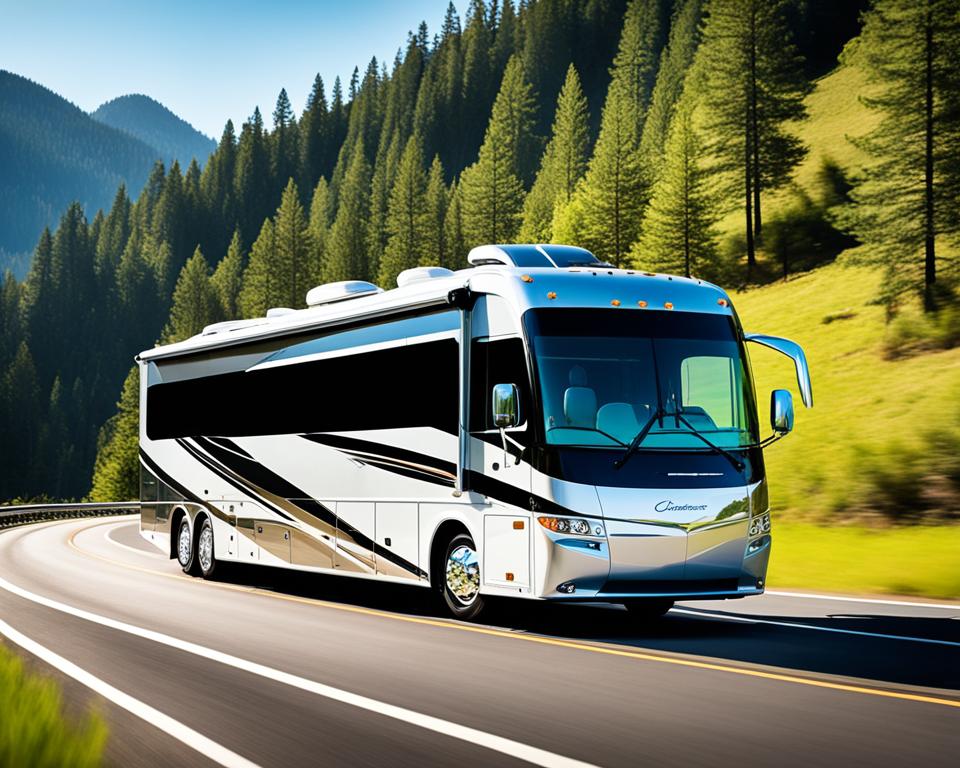Ensuring the safety of your motorhome is of utmost importance, and one crucial aspect to consider is the replacement of your tires. But how often should motorhome tires be replaced? Determining the ideal frequency for motorhome tire replacement is a common question among RV owners.
In this article, we will provide you with essential information on when and how often you should replace your motorhome tires. By following expert recommendations and real-life experiences, you can make informed decisions to keep your motorhome safe and roadworthy.
Key Takeaways:
- Regularly inspect your motorhome tires for signs of damage, including bulges, cuts, debris lodged in the tread, and irregularities.
- Dry rot can occur due to excessive sun exposure, heat, and low inflation, so proper storage and cleaning practices are essential.
- Motorhome tires have an average lifespan of five to seven years, but factors like usage and storage conditions can impact their longevity.
- Monitor your tires for signs of wear and tear, including uneven wear, loss of tread, and tread depth below recommended levels.
- Avoid motorhome tire blowouts by ensuring proper inflation, avoiding overloading, and maintaining even weight distribution.
Now that we’ve covered the introduction, let’s dive deeper into the signs of damaged motorhome tires and learn how to determine their age.
Signs of Damaged RV Tires
Regularly inspecting your RV tires is crucial to ensure their safety and longevity. By monitoring signs of damage and practicing proper maintenance, you can prevent accidents and costly repairs. Here are some key indicators to watch out for:
- Bulges: Bulges on the tire sidewall indicate internal damage or weak spots, which can potentially lead to a blowout.
- Cuts: Deep cuts or gashes in the tire tread or sidewall could compromise the strength and performance of the tire.
- Debris lodged in tread: Rocks, nails, or other foreign objects stuck in the tire tread can cause punctures or impact the tire’s balance.
- Irregularities: Any visible irregularities, such as indentations or distortions, may suggest structural issues within the tire.
- Dry rot: Dry rot is a common problem in motorhome tires and occurs due to prolonged exposure to sunlight, heat, and low inflation. It weakens the tire’s rubber, making it more prone to failure.
It’s important to inspect both the outer and inner sides of the tire, especially for dual tires where damage may not be easily visible. Thoroughly examine your RV tires before and after trips, as well as during regular maintenance checks.
To give you a better idea, here’s an illustrative table that summarizes the signs of damaged RV tires and their potential consequences:
| Signs of Damaged RV Tires | Potential Consequences |
|---|---|
| Bulges | Risk of tire blowout and loss of control |
| Cuts | Possible tire failure and increased vulnerability to punctures |
| Debris lodged in tread | Increased risk of punctures, loss of traction, and uneven wear |
| Irregularities | Potential tire instability and compromised handling |
| Dry rot | Reduced tire strength, increased susceptibility to blowouts |
Remember, promptly addressing any signs of damage or wear on your RV tires will help ensure your safety on the road. Take the necessary steps to repair or replace damaged tires to avoid accidents and maintain optimal performance. Prioritize regular motorhome tire maintenance to extend their lifespan and enjoy worry-free travel.
Determining Motorhome Tire Age
The age of your motorhome tires is a critical factor in determining when they should be replaced. On average, motorhome tires have a life expectancy of five to seven years. However, tires that are not regularly used may age even faster. It is essential to consider the age of your tires when deciding whether it is time for replacement.
Regularly inspecting your motorhome tires for signs of wear and tear is crucial in assessing their age and determining if replacement is necessary. Signs such as cracks, bulges, or worn-out tread indicate that the tires may be reaching the end of their lifespan.
Pro tip: To determine the age of your tires, check for the manufacturer’s date code imprinted on the sidewall. This code provides information about the week and year the tire was produced. It is recommended to replace your motorhome tires if they are more than seven years old, even if they appear to be in good condition.
Replacing your motorhome tires before they reach their maximum lifespan is essential for maintaining safety on the road and minimizing the risk of tire failure. The weight and size of a motorhome place additional stress on tires, making regular replacement even more critical.
| Average Motorhome Tire Lifespan: | Recommended Replacement Time: |
|---|---|
| 5 to 7 years | Replace tires older than 7 years |
Keep in mind that the recommended replacement time might vary based on specific factors such as tire quality, usage, maintenance, and climate conditions. If you frequently travel long distances or operate your motorhome in extreme climates, you may need to replace your tires more frequently.
Regularly inspecting and monitoring the age of your motorhome tires will help ensure your safety and the optimal performance of your vehicle on the road.
Signs of Wear and Tear on Motorhome Tires
Even if your motorhome tires are not yet five years old, it is important to monitor them for signs of wear and tear. This regular inspection can help you identify potential issues early on and ensure the safety of your vehicle.
One of the most noticeable signs of wear and tear is uneven tread wear. If you notice that the tread on your tires is wearing down unevenly, it may indicate the need for replacement. Uneven wear can be caused by various factors such as improper alignment, over or under-inflation, or suspension problems.
Loss of tread depth is another significant sign to look out for. The minimum tread depth for RV tires in the front is 4/32nd of an inch, while in the rear, it is 2/32nd of an inch. However, many motorhome owners choose to replace their tires sooner due to the weight and cost of RVs and trailers. Tires with low or worn-out tread can have reduced traction, especially on wet or slippery roads, increasing the risk of accidents.
Regular inspections can be done visually, but you can also use a tread depth gauge to measure the exact tread depth of your motorhome tires. By monitoring the wear and tear on your tires, you can make informed decisions about when it’s time to replace them, ensuring the optimal performance and safety of your motorhome.
Motorhome Tire Wear and Tear Inspection Checklist:
- Check for uneven tread wear patterns on all tires.
- Measure the tread depth using a tread depth gauge.
- Look for any visible signs of damage, such as cuts or bulges.
- Inspect the sidewalls for cracks or signs of dry rot.
- Ensure that the tires have proper inflation pressure.
| Signs of Wear and Tear | Actions to Take |
|---|---|
| Uneven tread wear | Have your motorhome tires professionally inspected for alignment or suspension issues. Consider replacing the tires if necessary. |
| Low tread depth | If the tread depth is approaching the minimum limit or if you notice significant wear, it is recommended to replace the tires to maintain optimal traction and safety. |
| Visible damage (cuts, bulges) | Replace the damaged tire(s) immediately to prevent the risk of tire failure or blowouts. |
| Cracks or dry rot on sidewalls | Even if the tread depth appears fine, cracks or signs of dry rot on the sidewalls indicate tire deterioration. It is best to replace the tires to avoid potential failure. |
| Improper inflation pressure | Regularly check and maintain the correct inflation pressure for your motorhome tires. Underinflation or overinflation can lead to uneven wear and reduced tire performance. |
By staying vigilant and conducting routine inspections, you can identify signs of wear and tear on your motorhome tires and take appropriate action to ensure your safety on the road.
Avoiding Motorhome Tire Blowouts
Motorhome tire blowouts can be dangerous and should be avoided at all costs. The leading cause of these blowouts is underinflated tires, which generate excessive heat and eventually fail. However, other factors such as overloading, unseen tire damage, excessive heat, and uneven weight distribution can also contribute to tire failure. To minimize the risk of a blowout and ensure your safety on the road, it’s important to follow these motorhome tire safety tips:
- Regularly check and maintain the proper tire pressure for your motorhome. Refer to the manufacturer’s guidelines or consult a professional if you’re unsure.
- Avoid overloading your motorhome beyond its weight capacity. Distribute the weight evenly and make sure it’s within the limits specified by the manufacturer.
- Inspect your tires before every trip for any signs of damage, such as bulges, cuts, or debris lodged in the tread. If you notice any abnormalities, have them checked by a professional.
- Ensure your tires are properly inflated and in good condition before embarking on a long journey.
- Have your motorhome tires regularly inspected by professionals who can identify any potential issues or signs of wear and tear.
In addition to these safety tips, it is crucial to use reliable tires that are designed for motorhome use. Choosing tires that are suitable for the weight and requirements of your motorhome can significantly reduce the risk of a blowout. Regular maintenance, inspections, and proactive care will go a long way in preventing motorhome tire blowouts and keeping you and your passengers safe on the road.
Preemptive Motorhome Tire Replacement
If you are embarking on an extended trip, it is recommended to consider preemptively changing your motorhome tires. This not only provides peace of mind but also ensures that you won’t have to interrupt your journey or replace tires in an unfamiliar location.
Safety should always be prioritized when it comes to motorhome tire replacement as delaying replacement could lead to damage to your RV and put yourself and your family at risk. By taking the proactive approach of replacing your tires before heading out on your trip, you can greatly reduce the chances of encountering tire-related issues along the way.
| Benefits of Preemptive Motorhome Tire Replacement |
|---|
| Peace of mind during your trip |
| Avoidance of unexpected tire issues |
| Reduced chances of damage to your RV |
| Enhanced safety for you and your family |
By investing in new tires before your journey, you can set off with the confidence that your motorhome is equipped with reliable and road-worthy tires capable of handling the demands of your trip. Don’t let worn-out tires become an obstacle to your travel plans.
Remember, your motorhome tires are the only point of contact between your vehicle and the road. Taking preemptive measures to ensure their reliability and performance is an essential part of responsible motorhome ownership. So, before you embark on your next adventure, consider preemptive tire replacement to make your journey safer and more enjoyable.
Regular Motorhome Tire Maintenance
To ensure the longevity and optimal performance of your motorhome tires, regular maintenance is essential.
Here are some key maintenance practices you should follow:
- Periodically check tire pressure: Maintaining proper tire pressure is crucial for both safety and tire lifespan. Underinflated tires can lead to decreased fuel efficiency, uneven wear, and potential blowouts. Use a tire pressure gauge to check the pressure regularly and adjust as needed.
- Rotate and balance tires: Rotating your motorhome tires regularly helps distribute wear and tear more evenly, extending their overall lifespan. Additionally, balancing the tires ensures smooth and comfortable driving, reducing vibrations and enhancing stability.
- Maintain safe driving habits: Avoid sudden stops, starts, and turns. Excessive acceleration and braking can lead to faster tire wear. Be cautious when driving over potholes, curbs, or other obstacles that can cause tire damage.
- Avoid tire overload: Make sure you’re not exceeding the maximum load capacity of your motorhome tires. Overloading can lead to accelerated wear and potential tire failure. Refer to your motorhome’s user manual or contact the manufacturer to determine the appropriate weight limits.
- Proper storage and cleaning: When your motorhome is not in use, store it in a dry, cool place away from direct sunlight. Excessive exposure to sunlight can cause tire deterioration. Clean your tires regularly using mild soap and water to remove dirt and debris.
By following these maintenance practices, you can maximize the lifespan of your motorhome tires and ensure a safe and enjoyable RVing experience.

| Maintenance Practice | Description |
|---|---|
| Periodically check tire pressure | Regularly monitor and adjust tire pressure to maintain optimal performance and safety. |
| Rotate and balance tires | Distribute tire wear evenly and ensure smooth, comfortable driving. |
| Maintain safe driving habits | Drive responsibly to minimize tire wear and prevent damage. |
| Avoid tire overload | Do not exceed the maximum weight limits recommended for your motorhome tires. |
| Proper storage and cleaning | Store your motorhome in a suitable environment and clean the tires regularly to prevent damage. |
Choosing the Right RV Tire
When it comes to selecting new RV tires, it’s essential to make the right choice for your motorhome. Factors such as tire type, weight rating, and size play a crucial role in ensuring safe and reliable performance on your journeys. Let’s explore the key considerations when choosing the perfect RV tire to enhance your motorhome experience.
Types of RV Tires
There are two main types of RV tires to choose from: radial tires and bias tires. Radial tires feature rubber-coated steel cables running perpendicularly, offering improved fuel efficiency and a smoother ride. They are ideal for longer trips and provide enhanced stability and traction on various road surfaces.
Bias tires, on the other hand, have nylon textile cords at a 30-degree angle. These tires are better suited for heavier loads and off-road adventures, making them the preferred choice for off-roading enthusiasts and those with larger motorhomes.
Tire Weight Rating and Size
Ensuring that your RV tires have the appropriate weight rating and size is crucial for maintaining optimal safety and performance. The weight rating indicates the maximum load capacity of the tire, so it’s essential to choose tires that can handle the weight of your motorhome and any additional cargo.
Additionally, selecting the correct tire size is vital to ensure a proper fit and compatibility with your RV. Consult your motorhome’s manual or a professional tire expert to determine the correct tire size for your specific vehicle model.
| Tire Type | Benefits |
|---|---|
| Radial Tires | – Improved fuel efficiency – Smoother ride – Enhanced stability and traction |
| Bias Tires | – Suited for heavier loads – Ideal for off-road adventures |
Choosing the right RV tire is crucial for a safe and enjoyable motorhome experience. Consider the type, weight rating, and size of the tire to ensure optimal performance and reliability. Now, let’s move on to the next section to learn about proper storage and care for your RV tires.
Proper Storing and Caring for RV Tires
Proper storage and care of RV tires are essential for maintaining their quality and longevity. By following these guidelines, you can ensure that your RV tires stay in optimal condition for safe and worry-free travels.
To start, store your motorhome in a dry and cool place, away from direct sunlight. Excessive heat and UV rays can cause cracking and dry rot, compromising the integrity of your tires. Additionally, consider using tire covers to provide an extra layer of protection against sun damage.
Regularly checking the tire pressure while the RV is in storage is crucial. Tire pressure can fluctuate due to changes in temperature, so it’s important to maintain the recommended pressure levels to prevent damage. Use a reliable tire pressure gauge to monitor and adjust the tire pressure as needed.
When storing your RV for an extended period, it’s a good idea to lift it off the ground using jack stands or lift blocks. This helps to relieve the weight on the tires, preventing flat spots and unnecessary stress.
Remember, your RV tires are designed to support the weight of your motorhome, so avoiding tire overload is essential. Stay within the recommended weight limits specified by the manufacturer to ensure optimal tire performance and longevity.
“Proper storage and care of your RV tires are vital to maintaining their longevity and performance. By following these practices, you’ll be able to enjoy safe and worry-free adventures on the road.”
By adhering to these storage and care practices, you can extend the lifespan of your RV tires and ensure their optimal performance throughout your journeys. Prioritizing proper storage, regular tire pressure checks, and avoiding excessive weight will help keep your tires in top condition, improving both safety and overall travel experience.
To provide visual representation, take a look at the table below for a quick summary of the essential RV tire storage and care practices:
| RV Tire Storage and Care Practices |
|---|
| Store your motorhome in a dry and cool place, away from direct sunlight |
| Use tire covers to protect against UV damage |
| Regularly check tire pressure while in storage and adjust as needed |
| Lift the RV off the ground with jack stands or lift blocks during long-term storage |
| Avoid tire overload by staying within recommended weight limits |
Following these guidelines will help you ensure the optimal condition of your RV tires, enhance their lifespan, and promote a safer and more enjoyable travel experience.
Understanding RV Tire Lifespan and Replacement Frequency
The lifespan of RV tires can vary depending on various factors, such as maintenance, usage, and exposure to environmental conditions. On average, well-maintained RV tires can last around four to five years. However, it is important to regularly inspect tires for signs of wear and consider other factors like tire quality, load capacity, and age when determining the need for replacement. It is always better to err on the side of caution and prioritize safety when it comes to RV tire replacement.
Proper maintenance and regular inspections are vital in prolonging the lifespan of your RV tires. By conducting routine visual checks and ensuring proper tire inflation, you can identify potential issues and address them before they become critical. Additionally, proper storage and cleaning practices, such as using tire covers and keeping tires out of direct sunlight, can help prevent premature deterioration and extend tire life.
When it comes to replacement, there are a few signs to watch out for. If your RV tires have reached the age of five years or more, it is advisable to consider replacing them, even if they appear to be in good condition. Factors such as heat, UV exposure, and fluctuations in tire pressure can contribute to internal damage that may not be visible from the outside.
Remember, your safety and the safety of your loved ones should always come first when it comes to RV tire replacement.
Here’s a table summarizing the average lifespan and common signs for replacing RV tires:
| Tire Lifespan | Signs for Replacement |
|---|---|
| Approximately four to five years with proper maintenance |
|
Tire Rotation
To ensure even wear and maximize tire lifespan, regular tire rotation is essential. This involves systematically moving the tires from one position to another on your RV. Front tires should be swapped with the rear tires, and left tires exchanged with the right ones. By rotating your RV tires every 5,000 to 8,000 miles or at least once every six months, you can ensure that they wear uniformly, leading to better performance and longevity.
Tips for Extending RV Tire Life
Proper care and maintenance are key to extending the life of your RV tires. By following these tips, you can ensure the longevity and optimal performance of your tires:
- Regular tire inspections: Inspect your tires regularly for signs of wear, damage, or irregularities. Keep an eye out for bulges, cuts, debris lodged in the tread, and tread depth.
- Tire rotation: Rotate your RV tires regularly to distribute wear evenly. This helps prolong their lifespan and ensures balanced performance.
- Maintaining proper tire pressure: Check and maintain the correct tire pressure as recommended by the manufacturer. Underinflated or overinflated tires can lead to premature wear and reduced fuel efficiency.
- Getting regular alignments: Proper wheel alignment is crucial for even tire wear and optimal handling. Alignments should be done at regular intervals or whenever you notice signs of misalignment.
- Using a tire pressure monitoring system: Invest in a reliable tire pressure monitoring system to keep track of tire pressure and temperature. This helps detect issues early and prevent tire damage.
- Storing tires correctly: When not in use, store your RV tires in a cool, dry place away from direct sunlight. UV rays can cause damage and accelerate tire aging. Using tire covers for added protection is also recommended.
- Replacing tires when necessary: Do not delay tire replacement when they show signs of excessive wear, damage, or aging. Replace them with quality tires that meet your RV’s specifications.
Following these tips will help maximize the lifespan and performance of your RV tires, providing you with a safe and smooth journey on the road.
Conclusion
Proper motorhome tire replacement and maintenance are essential for your safety on the road. By regularly inspecting your tires, monitoring signs of wear and tear, and following recommended maintenance practices, you can ensure optimal performance and longevity of your motorhome tires.
When it comes to motorhome tire replacement, it is always better to be proactive. Don’t wait for signs of damage or noticeable wear to appear. Regularly check your tires for bulges, cuts, and debris lodged in the tread, and pay attention to any irregularities. Remember, prevention is key!
By prioritizing your safety and the safety of your loved ones, you can avoid potential hazards and costly damages. Don’t hesitate to replace your RV tires when in doubt. It’s better to invest in new tires than to risk a blowout or compromise your motorhome’s performance.
So, make sure you schedule regular inspections, follow maintenance guidelines, and replace your motorhome tires whenever necessary. With proper care and attention, you can enjoy worry-free adventures on the road while ensuring the longevity and reliability of your motorhome tires.
FAQ
How often should motorhome tires be replaced?
Motorhome tires should typically be replaced every 5 to 7 years, depending on factors such as usage and maintenance.
What are the signs of damaged RV tires?
Signs of damaged RV tires include bulges, cuts, debris lodged in the tread, dry rot, and irregularities. Thorough inspection is necessary, especially for tires located inside duals.
How can I determine the age of my motorhome tires?
Motorhome tires can be dated by checking the DOT number on the sidewall. The last four digits indicate the tire’s manufacturing date, including the week and year.
What are the signs of wear and tear on motorhome tires?
Signs of wear and tear on motorhome tires include uneven wear and loss of tread. These signs indicate that it may be time for a replacement.
How can I avoid motorhome tire blowouts?
To avoid motorhome tire blowouts, it is important to maintain proper tire inflation, avoid overloading, maintain even weight distribution, and regularly inspect tires for damage and wear.
Should I consider preemptive motorhome tire replacement before a trip?
It is recommended to consider preemptive motorhome tire replacement before an extended trip to ensure safety and avoid unexpected tire issues during your journey.
How can I maintain my motorhome tires?
Regular motorhome tire maintenance includes checking tire pressure, rotating and balancing tires, and practicing safe driving habits. Proper storage and cleaning practices are also important.
How do I choose the right RV tire?
When choosing RV tires, consider factors such as tire type, weight rating, and size. Radial tires are suitable for long trips, while bias tires are better for heavy loads and off-road adventures. Ensure the tire weight rating and size match your RV’s requirements.
How do I properly store and care for RV tires?
Proper RV tire storage involves keeping them in a cool, dry place out of direct sunlight, using tire covers to protect them from UV damage, and regularly checking tire pressure. Lifting the RV off the ground with jack stands or lift blocks can also help prevent tire damage.
How long do RV tires last, and when should they be replaced?
On average, well-maintained RV tires last around four to five years. However, it is important to regularly inspect tires for signs of wear and consider factors like tire quality, load capacity, and age when determining the need for replacement.
How can I extend the life of my RV tires?
To extend the life of your RV tires, perform regular tire inspections, rotate and balance tires, maintain proper tire pressure, get regular alignments, and use a tire pressure monitoring system. Proper storage and timely replacement are also essential.
What are the recommendations for motorhome tire replacement?
When it comes to motorhome tire replacement, it is always better to prioritize safety. Regularly inspect your tires, monitor signs of wear and tear, and replace them as recommended by experts to avoid potential hazards and costly damages.













